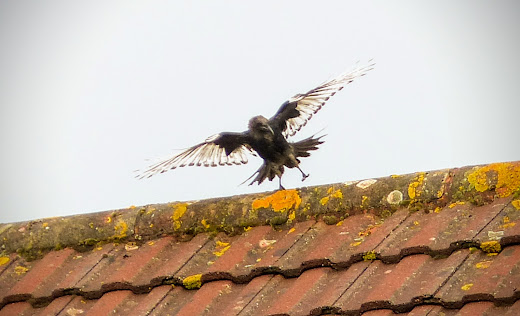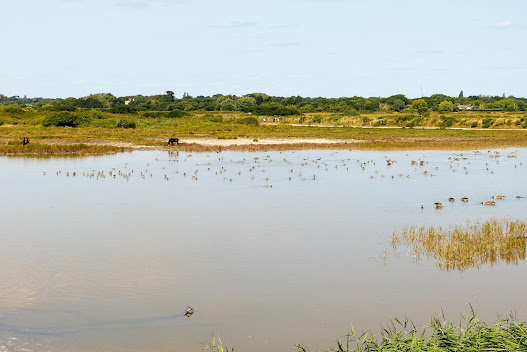Saturday 17th August 2024.
The gorgeous adult Spoonbill on Butts Lagoon, Pennington Marshes, today.
A dry, bright morning to start the weekend off with and the first port of call was the Moth Boxes in both my garden and Andy’s, up in Cowplain. I discussed with Matt & Emma Parkes about meeting up again and suggested Pennington Marshes as there has been some interesting waders been reported throughout the week there that included Curlew Sandpiper, Little Stint and a Ruff. It is a waders paradise there and with wader passage in full strength, there is always a chance of something rarer. There has been a variety of migrant birds throughout the week in Hampshire and more locally, the likes of Pied Flycatcher, Grasshopper Warbler and other scarce migrants have been seen. Even the Knepp flock of White Storks have been on the move with a large number seen in Upham, within the north of the County. The weather looks very settled over the weekend with light winds and plenty of sunshine.
The Moth Boxes:
Above, my first Flounced Rustic of the year and below, a pristine Bloxworth Snout.
Above, both Jersey and Garden Tiger moths sharing the same egg tray.
A total of 47 moths of 12 species this morning and among them was my first Flounced Rustic of the year. The highest number of Garden Tigers were present with a total of 12 individuals present, but possibly more scattered around the garden and even another Jersey Tiger were among them.
The moths recorded this morning included the following:
MACRO MOTHS:
- Lime-speck Pug 3
- Double-striped Pug
- Willow Beauty 6
- Pale Mottled Willow 2
- Bloxworth Snout
- Common Rustic 3
- Bright-line Brown-eye 2
- Garden Tiger 12
- Jersey Tiger
- Brimstone Moth 3
- Square-spot Rustic
- Marbled Beauty
- Flounced Rustic (New for Year)
MACRO MOTHS
- Common Plume 3
- Ruddy Streak
- Black-banded Masoner
- Chevron Grass-moth
- Garden Pebble 2
- Barred Marble
- Brown House Moth
Over at Andy’s garden, a total of 31 moths of 18 species were recorded that included two more new for the year: a superb Copper Underwing and the micro moth Plum Fruit Moth. There was an excellent supporting cast of my second male Four-spotted Footman of the year (had one last month in Devon). Micro moths were impressive too with Chestnut Tortrix, Oak Longhorn and Grey Knothorn being the pick of the other micros.
Above, my first Copper Underwing moth of the year and below, one of two Blair's Mocha's.
The moths present in Andy’s garden included the following:
MACRO MOTHS:
- Willow Beauty 8
- Copper Underwing (NFY)
- Uncertain 2
- Vine’s Rustic
- Four-spotted Footman (male)
- Blair’s Mocha 2
- Tree-lichen Beauty
- Garden Carpet
- Double-striped Pug
- Small Dusty Wave 2
MICRO MOTHS:
- Chestnut Tortrix
- Common Grass-moth 5
- Garden Grey
- Light Brown Apple Moth
- Dark-spotted Moss-moth
- Plum Fruit Moth (NFY)
- Oak Longhorn
- Grey Knothorn
Fishtail & Keyhaven Lagoon, Pennington Marshes:
Redshank & Dunlin resting on Fishtail Lagoon.
The long drive to the small Car Park at the bottom of Lower Pennington Lane paid off with just a few spaces left. We then took the walk to the seawall to meet up with both Emma and Matt Parkes. Matt quickly pointed out a Kingfisher that was fishing in the neighbouring stream and then a Green Sandpiper flew out of hiding and then flew onto Fishtail Lagoon, but soon disappeared. Earlier, we saw a Sparrowhawk soaring in the clear blue sky as we neared the car park.
Above, Geoff pointed out this attractive flowering plant called Soapwort that was growing in some bramble near the harbour wall. Personally, I have never heard of it! Below, the flock of Eider ducks out on the nearby islands.

The tide was on the rise within the Solent as more waders flew in to settle on Fishtail Lagoon and the Butts Lagoon nearby. The majority of waders present were Black-tailed Godwit and what with a Hudsonian Godwit seen in the north of the UK, always checking the local birds here. Two Common Sandpipers were seen on the muddy shoreline and other waders resting here on Fishtail Lagoon included a large number of Oystercatchers and a decent flock of Grey Plover (many in full summer plumage) on Keyhaven Lagoon. Up to 6 Avocets were present among the resting Gulls (that included both Great Black-backed and Lesser Black-backed, Black-headed Gull and a single adult Common Gull). A pair of Ringed Plovers on Fishtail Lagoon was also present along with a lone Turnstone, that was feeding close to the shoreline. The best wader of all was a Ruff that was feeding on its own on Keyhaven Lagoon and in this bright late morning light, it was a good opportunity to get some nice photos of this lovely wader.

Above, a flock of Black-tailed Godwit were on the islands among the many Canada Geese present on Fishtail Lagoon. Below, the Ruff was feeding on its own on Keyhaven lagoon.
More than once I heard a Yellow Wagtail call, though both were distant and then I picked out a much nearer one and quickly got Andy onto it for him to claim a ‘year-tick’ for his Hampshire year list. I had seen one earlier in the Spring, therefore I didn't need to add it to my year list. There was a good number of White Wagtails around too with at least 6 birds present among a smaller number of Pied Wagtails. Out in the Solent, by the islands, up to 12 Eiders were counted, all in eclipse plumage and a Great Crested Grebe swam in too. A Wheatear had flown from one of the small islands and then flew to the harbour wall and out of view. A distant Raven was first heard a few times and then seen flying distantly heading east and Emma picked out a female Marsh Harrier heading west and a female Kestrel high overhead.
Above, another photo of the Ruff and below, one of two Common Sandpipers on Fishtail Lagoon with a dabbling Mallard.
Above, a couple of Dunlin on Fishtail lagoon and below, a Kestrel hovering high in the sunshine.
In between both Fishtail and Keyhaven Lagoon, a clump of small trees and bushes held a few interesting passerines that included at least three Common Whitethroat, a Chiffchaff and a probable Reed Warbler. The same bushes attracted some butterflies too that included a male Common Blue and a few Meadow Browns. Little Egrets here were quite impressive with at least 15 birds counted along with several Grey Herons. Earlier today, a fellow birder told us that he had seen a Cattle Egret here, but the bird had long flown off.
Above, at least 6 Avocets were seen among the Gull flock and below, a very smart flock of Grey Plover was also on Keyhaven lagoon.
Above, Matt & Emma enjoying the waders on the Lagoons and below, one of many Swallows flying low over the Lagoons.
After the guys had their lunch (I, regrettably left mine in the boot of my car! Fume!), we decided to walk east to Butts Lagoon. A large flock of Black-tailed Godwit entertained on the Lagoon and a lone adult Spoonbill preened itself on the Lagoon, a species I could never get tired of watching. A pair of Little Grebes were seen swimming close to reedbeds and both Reed and Sedge Warblers were seen flitting about in the nearby reedbeds. Back out in the Solent, I regularly checked if any Terns were passing through and I did see up to four Common Terns fishing the Solent heading east, but little else over the flat calm sea and a lot of heat haze too.
Above, Golden Samphire growing below the seawall and below, Rock Samphire.
Above, this looks like a scene from a pool on the Serengeti? A large number of Little Egrets were feeding on the small fish that were abundant within the Lagoons.
On our walk by these two Lagoons, Geoff kindly identified a few plants growing on the seawall that included both Golden Samphire and Rock Samphire though Geoff assures me that the two plants are not related. Another interesting plant was the colourful Soapwort that was growing in the brambles nearby. One, maybe two, Emperor Dragonflies were on the wing along the harbour wall and a few Migrant Hawker dragonflies were also noted.
Above, a Great Crested Grebe swimming just offshore with a couple of Eider in the background. Below, a Common Whitethroat popped out briefly in the small clump of bushes.
Above, a Grey Heron was close to the seawall and below, the Eider just offshore.
Normandy Marshes from Butts Lagoon was a very long walk and so we decided to go back to the Car Park and drive there instead. Sadly, though we took the drive there, on walking around the area, we soon realised it was very quiet here. A few Common Buzzards were seen flying together on the way back, but as I was the only one who brought my scope, the only waders seen were quite distant on one of the islands of which I picked out mostly Redshank with a few Dunlin among them, but little else here of note bar a pair of Great Crested Grebes on the water. There were no Terns present, unlike the last time I was here when we were watching the Roseate Terns among the many Common Terns. The good news is that the Roseate Terns successfully raised two juveniles that went onto fledge.
Above, sadly, there was very little of note on Normandy Marshes apart from these two Great Crested Grebes and a small party of waders on one of the islands. Below, the adult Spoonbill on Butts Lagoon.
Above, a good 100+ Black-tailed Godwit were feeding on Butts Lagoon and below, this was one of the closer ones.
On the way back home, we all stopped off for a nice pint in one the pubs just outside Brockenhurst and then after that lovely refreshment, we made our way home. A great day with a great bunch of guys. Below, a selection of Emma's excellent photos she took today.
Above, the Ruff and below, a juvenile Reed Warbler.
Above, a Whimbrel and below, one of her target species to photograph, the Swallow.



































































.JPG)















